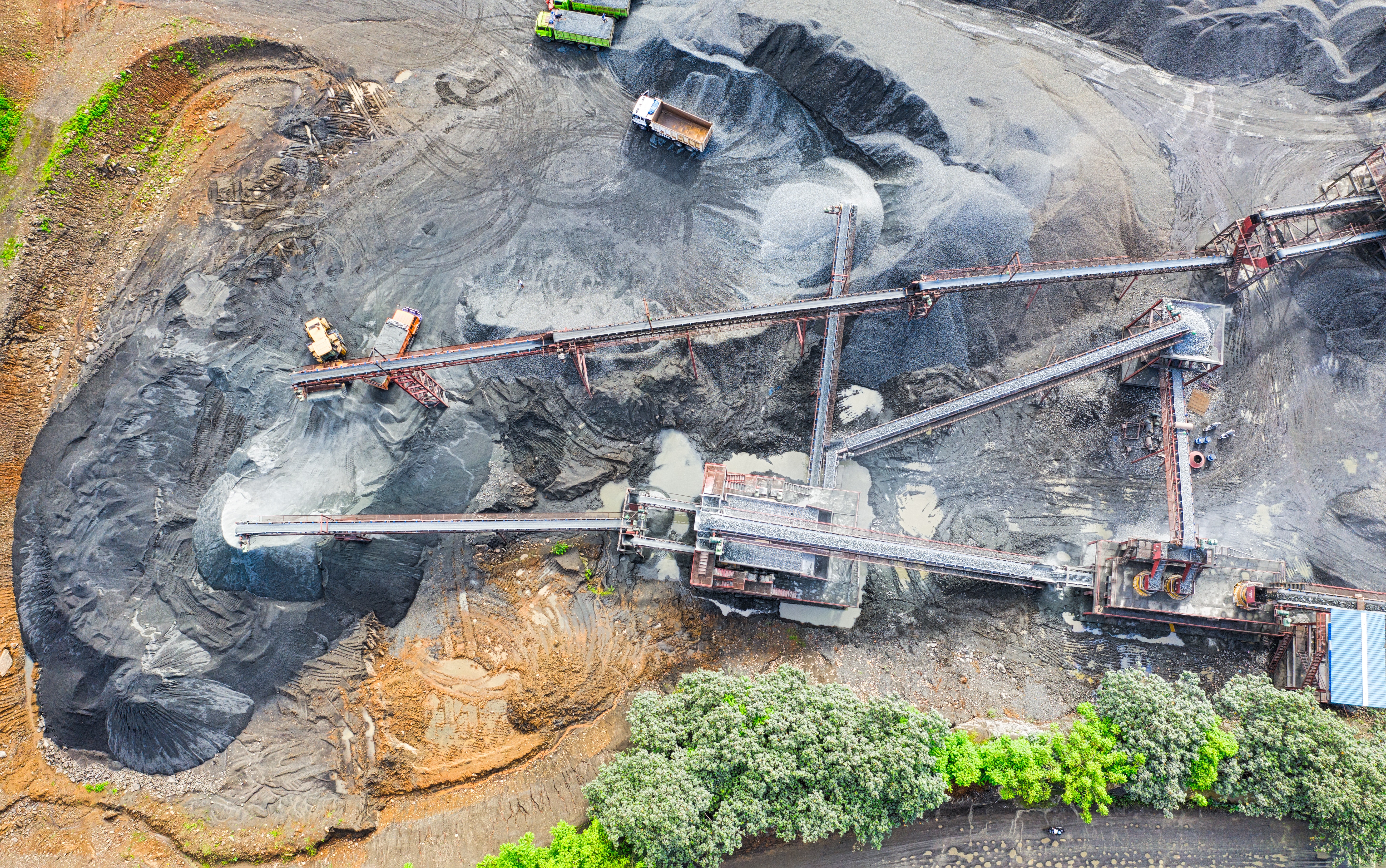
Mining North Korea: Magnesite Production at the Taehung Youth Hero Mine
The Taehung Youth Hero Mine “has established the Juche orientation in the production of fireproof materials and this can be called a revolution. It is a great achievement that has brought about an epochal turn in developing our industry. It is as significant as the success in a nuclear test.” — Kim Jong-il, May 20, 2009
Key Points
- Antiquated facilities, equipment, and processes together with the continual plague of electricity shortages will hinder any dramatic production increases of magnesite at North Korea’s Taehung Youth Hero Mine.
- While the Taehung Youth Hero Mine is ascribed a notable role in North Korea’s economy, reporting indicates sanctions limiting the North’s mineral exports continue to affect the magnesite industry by curtailing foreign currency earning and thereby its ability to acquire necessary parts and equipment.
- Should rapprochement happen between North and South Korea, South Korea is interested in North Korean exports of magnesia and non-ferrous and rare-earth minerals.
- However, even if international sanctions are lifted and North Korean exports of magnesia are allowed to increase, the investments costs to make North Korea’s magnesite mining industry operate at modern global standards would be tremendous.
- The size of the processing facilities, level of rail activity, presence of surface mine equipment (e.g., ore haul trucks, drill rigs, and shovels), and general levels of activity strongly indicate that the Taehung Youth Hero Mine is an active mine and suggest that it may be the primary producer of magnesite ore, magnesia, magnesia clinker, and related products in the Puktae-chon Valley – which includes Ryongyang Mine.
- Despite North Korean propaganda claims, damage caused by the August 2012 Typhoon Bolaven (known locally as Typhoon-15) has had long-lasting effects that have not yet been fully addressed as late as 2018.
The Democratic People’s Republic of Korea (DPRK, more commonly known as North Korea) is a nation with immense non-ferrous and rare-earth mineral reserves.1 Among these is magnesite, which has been mined in commercially viable quantities since the Japanese colonial period. While the estimates of North Korean magnesite reserves has fluctuated dramatically over the past 15 years, the United States Geological Survey (USGS) estimates that North Korea has 2.3 billion metric tons of magnesite reserves and that its total 2018 mine production of magnesite was 270,000 metric tons.2 While this is a decline from the 380,000 metric ton estimate for 2017, due to international sanctions imposed during 2017, it remains both an important export and domestic commodity for North Korea.3 Among the nations that have purchased magnesite from North Korea during the past 10 years, China is the largest customer by a large margin. Foreign analysts, especially in South Korea, believe that China’s large long-term purchases of North Korean rare-earth and non-ferrous minerals, including magnesite, are a component of a strategy to lock out competitors and influence world market pricing.4
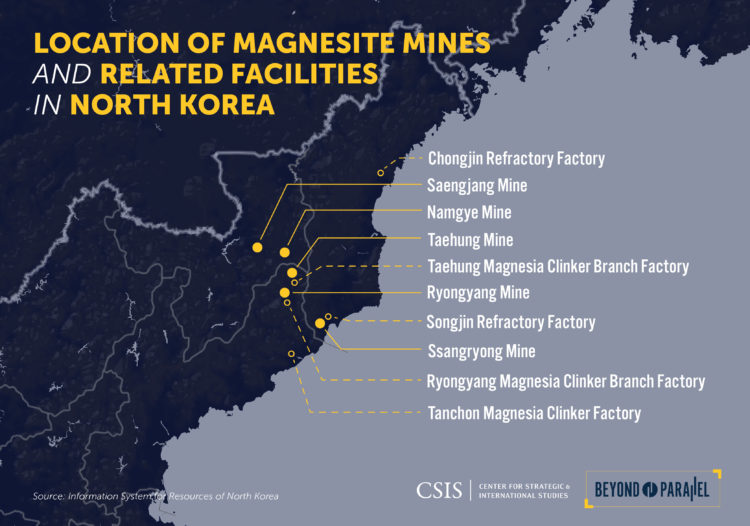
North Korea’s magnesite reserves are primarily distributed in Hambuk and Hamnam provinces in the northeastern part of the country, with 90 percent being located in the Tanchon area of Hamnam province. The remaining 10 percent are located in the Paegam-gun area of Ryanggang province and scattered around the nation.5 Among the magnesia-related facilities within these two provinces are the Namgye Mine, Ryongyang Magnesia Clinker Branch Factory, Ryongyang Mine, Saengjang Mine, Songjin Refractory Factory, Ssangyong Mine, Taehung Magnesia Clinker Branch Factory, and the Taehung Youth Hero Mine.6
Taehung Youth Hero Mine Introduction
Location:The Taehung Youth Hero Mine (40.901815 128.804703), commonly referred to as the Taehung Mine, is located in Tanchon-gun (Tanchon county), Hamnam (South Hamgyong province) and approximately 350 kilometers north-northeast of Pyongyang and 20 kilometers northeast of the Ryongyang Mine.7 The Taehung Youth Hero Mine, located on the southern hill mass above Puktuilryong (Puktuil Pass), and the Ryongyang Mine are the largest magnesite mines in North Korea and some of the largest in the world.8
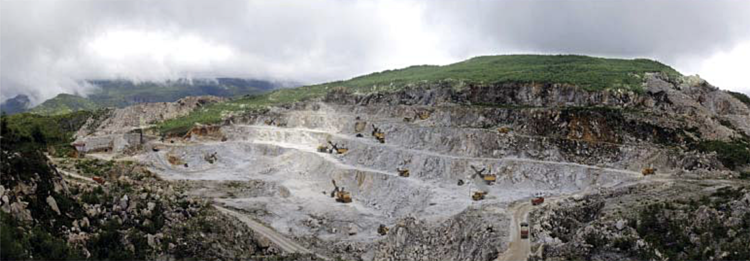
Management: The Taehung Youth Hero Mine, along with the Ryongyang Mine, is a component of the considerably larger Tanchon District Mining Bureau that oversees mining in Tanchon-gun.9 This bureau is itself subordinate to the Ministry of Mining Industry and mining rights are granted by the central government in Pyongyang.10 Magnesite mining operations under the bureau extend north from the port city of Tanchon, distributed along the valleys of the Namdae-chon (i.e., Namdae stream) and Puktae-chon (i.e., Puktae stream).
Reserves and Production: While a May 2018 South Korean report placed the magnesite reserves at the Taehung Youth Hero Mine at 640 million tons, a North Korean report from mid-2018 states, somewhat improbably, that the mine possesses “a high-grade magnesite deposit of more than 5 billion tons.”11 The mines magnesite is reportedly of high-grade, being 46.5-46.7 percent magnesium oxide, a naturally occurring form of magnesium.12 The mine is also reported to contain “deposits of white talcum, chlorite, arsenious anhydride, red granite and other useful minerals amounting to hundreds of millions of tons.”13
Information in the report by Cho Kyewan appears to be the basis for a later Chinese report. See: Quan Zhenan and Li Gengqian. “North Korean Mineral Resources: Rich Reserves, Weak Development, and Great Potential for Cooperation” Shijie Zhishi, September 2018, pp. 25-27.] South Korea estimates the annual production capacity at the Taehung Youth Hero Mine to be 1 million tons of ore.
The Taehung Youth Hero Mine reportedly alternates between open-pit surface and underground mining operations at the Muhak-tong Branch Mine, with underground mining operations being employed during the winter season. The ratio of the mine production is reported to be 70 percent open-pit mining to 30 percent underground mining.
Processing and Distribution: In addition to the mining of magnesite ore and the production of magnesite concentrate by the Taehung Youth Hero Mine, the Taehung Magnesia Clinker Branch Factory reportedly produces “high-quality magnesia clinker” and other magnesite products.14 The ore, clinker, magnesite products, and other ore produced by the Taehung Youth Hero Mine are shipped in bulk by rail to the Tanchon Magnesia Factory, Songjin Refractory Factory, and ports of Tanchon and Kimchaek.15
Analysis: As observed in all satellite imagery reviewed for this report, the size of the processing facilities, level of rail activity, presence of surface mine equipment (e.g., ore haul trucks, drill rigs, and shovels), activity at vehicle maintenance and storage facilities, expanding footprint of the area covered by mine tailings and general levels of activity strongly indicate that the Taehung Youth Hero Mine is an active mine and suggest that it may be the primary producer of magnesite ore, magnesia, magnesia clinker, and related products in the Puktae-chon Valley – which includes Ryongyang Mine.
While North Korean sources repeatedly talk of increased production from the Taehung Youth Hero and Ryongyang mines, it is clear that four factors have inhibited and will continue to inhibit any dramatic increase in production:
- The facilities, equipment, and processes used in magnesite extraction and processing are antiquated and in desperate need of modernization.
- Despite being close to major hydroelectric power plants, electricity shortages continue to plague industrial facilities throughout Hamnam and Hambuk Provinces due to antiquated equipment and a failing distribution network. A South Korea Mine Survey team’s 2011 report states that North Korean mines “have very weak electric systems and low-quality electricity (voltage values in North Korea are approximately 130-205 V, normal voltage is 220V) and frequency variations are 39-54Hz (normal frequency is 60Hz).”16 This low-quality or “dirty” electricity, when it is available, causes excessive wear on electrical equipment.17
- Despite North Korean propaganda claims, damage caused by the August 2012 Typhoon Bolaven (known locally as Typhoon-15) has had long-lasting effects that have not been fully addressed as late as 2018.18
- Finally, analysis of open source reporting concludes that international sanctions limiting North Korea’s ability to export minerals continue to affect the magnesite industry, as well as North Korea’s overall economy. By limiting foreign currency earning, sanctions effect the North’s ability to acquire spare parts or replace antiquated equipment.
Taehung Youth Hero Mine Description
The Taehung Youth Hero Mine is frequently identified in both North Korean and South Korean sources and described as consisting of collections of facilities including the Puktu-dong Branch Mine (Taehung Youth Hero Mine), Muhak-tong Branch Mine, Taehung Magnesia Clinker Branch Factory, additional processing and production facilities, and a number of support facilities (e.g., railroad stations and electrical substations). Additionally, satellite imagery shows the presence of housing, agricultural, social, and other facilities that support the workers from the mine and political and social entities. These activities spread out along approximately 10 kilometers of the upper reaches of the Puktae-chon Valley’s branches and are concentrated near Taehung-ni, Yangchon-dong, Muhak-tong, and Puktu-dong. 19 The Puktae-chon Valley is served by what is popularly known as the Tanchon-Kumgol electrified branch rail line that passes through 29 railroad tunnels before reaching the end of the line at the Muhak-tong rail yard.20 The Taehung Youth Hero Mine itself is serviced by the three rail yards/stations at Taehung-ni, Yangchon-dong, and Muhak-tong.
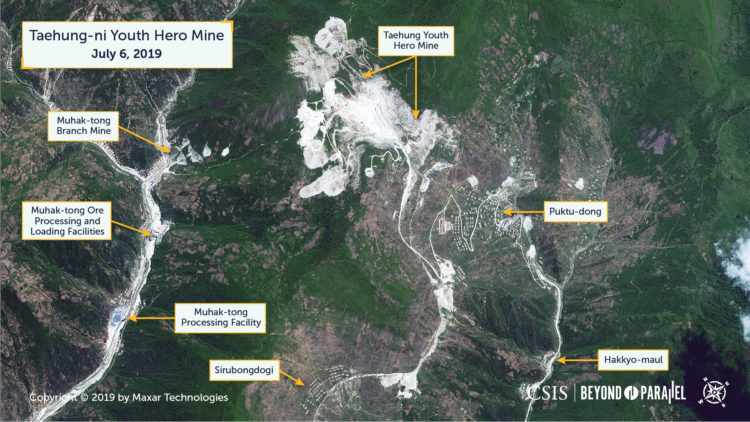
Although the precise details concerning the mine’s organization and the specific locations of its various activities and facilities are lacking, the following are among the most often reported in the open source:21
- Puktu-dong Branch Mine (Taehung Youth Hero Mine)22
- Muhak-tong Branch Mine23
- Muhak-tong ore processing and loading facilities
- Taehung Magnesia Clinker Branch Factory at Yangchon-dong24
- Briquette Factory
- Light-burned Magnesia Factory25
One source also identifies four mines named Hyoksin, Paksan, 6.22, and Red-flag, although it is unclear whether some of these are the same or different from those named above.
With the combination of both satellite imagery and open-source reporting (including North Korean-provided ground imagery), some of these activities can be located with relatively reliable accuracy. Others, however, simply cannot be located with accuracy at the present time due to the lack of reliable information and challenges in disambiguating the information that is available.
Located approximately 14 kilometers up the Puktae-chon Valley from Kumgol (Komdok) is the village of Taehung-ni. It is here that the area of the Taehung Youth Hero Mine can be said to begin. Here, a road forks to the east and climbs up the mountain past Hakkyo-maul and Puktu-dong to the site of the Puktu-dong Branch Mine. The rail line and main road continue north through Yangchon-dong and the Taehung Magnesia Clinker Branch Factory and other processing facilities before turning east to Muhak-tong and the ore processing and loading facilities.
The village of Taehung-ni extends approximately 3.5 kilometers along both sides of the Puktae-chon and approximately 1 kilometer up the branch road to the Puktu-dong Branch Mine. It appears to serve as the administrative headquarters and logistic base and primary housing area for the facilities associated with the Taehung Youth Hero Mine. The largest rail yard along the Tanchon-Muhak-tong rail line and an electrical substation are located here.
While available imagery from 2012-2017 is limited, it can be observed that portions of Taehung-ni were damage or destroyed in the 2012 flood. By 2017, the damage was repaired and the village slightly enlarged. At the rail yard on the north side, the size of tailings pile had expand by approximately 30 percent by the end of 2017. Whether this is because of changes in the sequence of ore processing or a result of the international sanctions imposed during 2016, and more significantly 2017, is unknown.


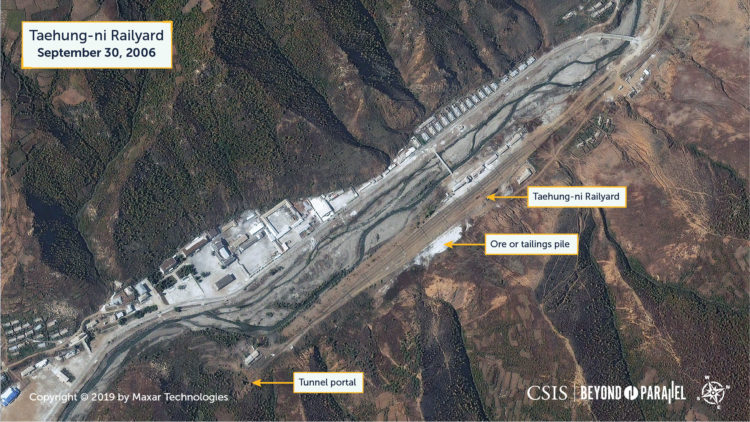

Approximately 3.5 kilometers north of Taehung-ni on the east side of the Puktae-chon at Yangchon-dong are the main processing facilities for the Taehung Youth Hero Mine. These consist of the Taehung Magnesia Clinker Branch Factory, Light-burned Magnesia Factory, Briquette Factory, several unidentified processing facilities, storage silos, a railyard, rail loading/unloading facilities, and several unidentified support facilities. South Korean sources estimate that the Taehung Magnesia Clinker Branch Factory has a designed total processing capacity of 600,000 tons per annum of magnesite ore.26
As with the village of Taehung-ni, the 2012 flood reportedly caused significant damage to the processing facilities at Yangchon-ni. According to North Korean statements this damaged was repaired during 2013-2014, although there are hints in later reports that some repairs have not yet been completed or that a decision had been made to simply leave some of the damage unaddressed. While available imagery between 2012-2017 is lacking, an image acquired in 2018 indicates that minor razing and construction activity had taken place since 2012. While most of this activity was undoubtedly in response to flood damage, it is unknown if its scale is attributable to international sanctions imposed during 2016 and 2017.
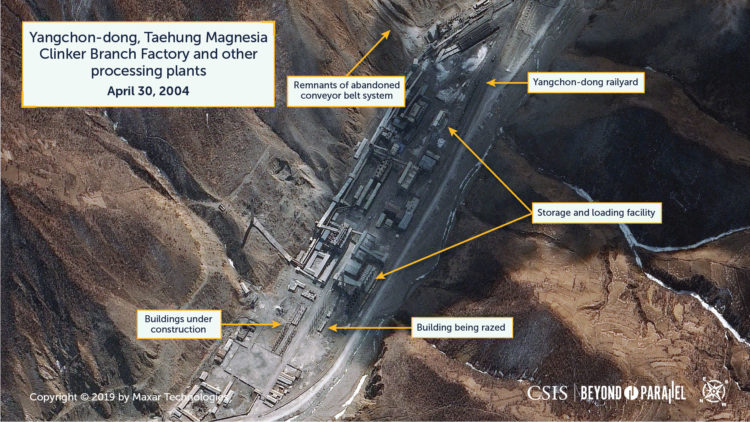
The Taehung Magnesia Clinker Branch Factory and other processing plants at Yangchon-dong, April 30, 2004. (Copyright 2019 by Maxar Technologies) 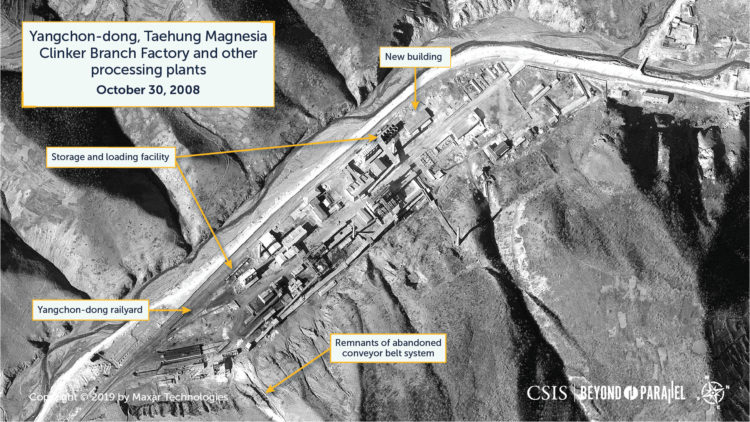
The Taehung Magnesia Clinker Branch Factory and other processing plants at Yangchon-dong, October 30, 2008. (Copyright 2019 by Maxar Technologies) 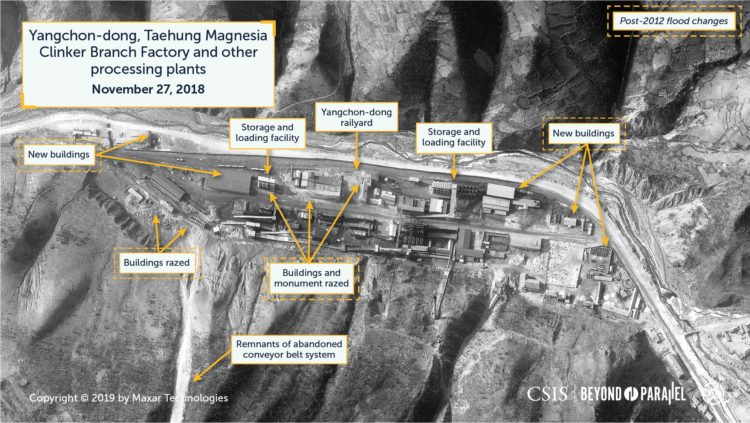
The Taehung Magnesia Clinker Branch Factory and other processing plants at Yangchon-dong, November 27, 2018. This image shows some of the construction work completed in the aftermath of the 2012 flood. (Copyright 2019 by Maxar Technologies)
In the satellite images reviewed for this report, rail cars (primarily gondolas) and locomotives have been present at the loading/unloading facilities and in the railyard in numbers higher than those observed at the Kumgol railyard servicing the Ryongyang Mine.
On the southeast corner of this area satellite imagery shows what appears to be the remains of an abandoned, long-distance conveyor belt system that originated at a small abandoned surface mine above the area. About 400 meters to the south of this is an abandoned, partially-elevated rail loading/unloading track that originated at another small abandoned surface mine up the mountain.


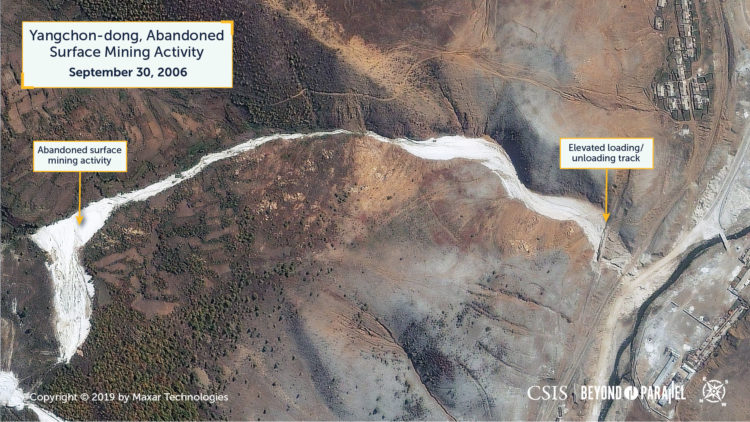

Located approximately 3.2 kilometers east of Yangchon-dong at Muhak-tong are the Muhak-tong Branch Mine, ore processing and loading facilities, and rail yard. The town of Muhak-tong, which spreads into two small valleys, serves as the administrative headquarters and primary housing area for these facilities and workers.
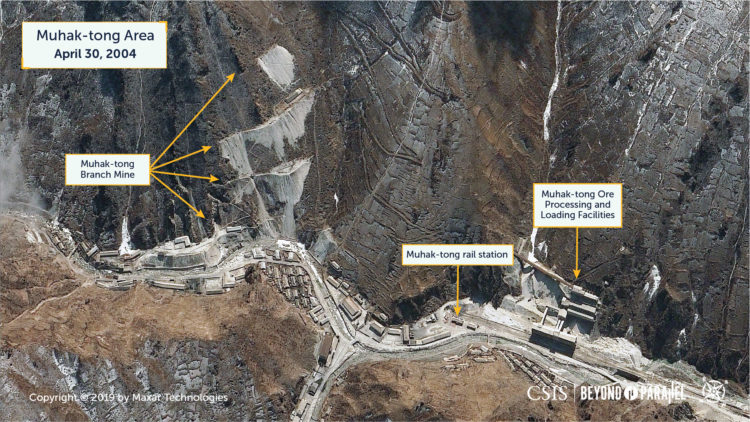
Satellite imagery shows that the portal for the Muhak-tong Branch Mine and its support facilities are located on the west side of town. Located in the mountainside above the portal are at least five small adits. During 2017, it was reported the mine introduced sub-level mining to expand the output of the mine and normalize the operations of the No. 1 and No. 2 large-scale crushers and the long-distance conveyor belt to increase mineral output by 1.15 times compared to the same period of the previous year.


Ore processed here is sent by rail not only to the Taehung Magnesia Clinker Branch Factory and other processing facilities at Yangchon-dong but also to the Tanchon Magnesia Clinker Factory and probably to the Ryongyang Magnesia Clinker Branch Factory at Kumgol.
As indicated in satellite imagery, the Muhak-tong ore processing facility, rail loading facility, and railyard are located on the west side of the town. The processing facility is located on a hillside and consists of a rock crusher (primary and secondary), screening and filtering lines, and storage facility. The rock crusher is connected by a covered conveyor belt that extends east across a small valley to an adit connected to the Muhak-tong Branch Mine. In the small valley under the covered conveyor belt is an open ore storage area with several large loading shovels. Immediately below the processing facility, and connected by conveyor belts, is an enclosed rail loading facility.



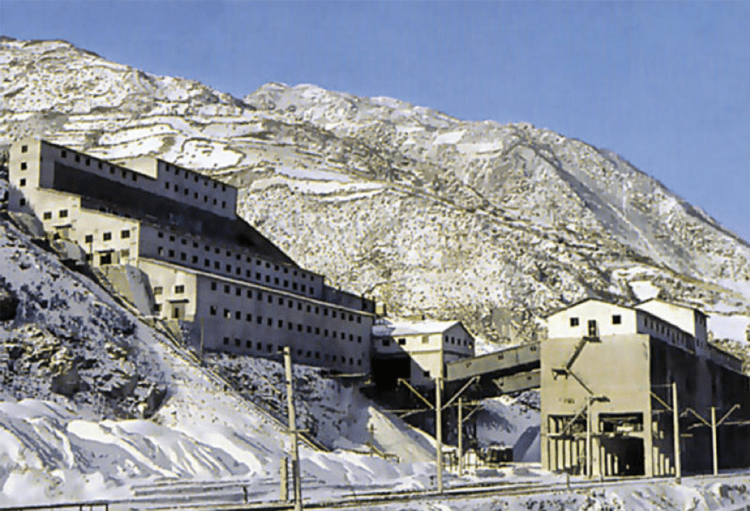
Limited satellite imagery between 2011-2015 shows that significant damage to housing, government, and rail structures was caused by the 2012 flood. Much of this was repaired by 2015. What impact this had upon the mining infrastructure is unknown but North Korean reports indicate that the Muhak-tong Branch Mine, and likely the Muhak-tong ore processing and loading facility, were temporarily shut down. Similar reports indicate that all these facilities were operational, to some degree, by the end of 2013. Limited satellite imagery between 2015-2019 shows that the ore pile at the Muhak-tong ore processing and loading facility appears to have increased slightly.
Located 700 meters west of the Muhak-tong ore processing facility is a small unidentified processing plant. Being located low and adjacent to the river it was undoubtedly seriously damaged during the 2012 flood and satellite imagery from 2019 shows that the facility and much of the nearby housing had been rebuilt.
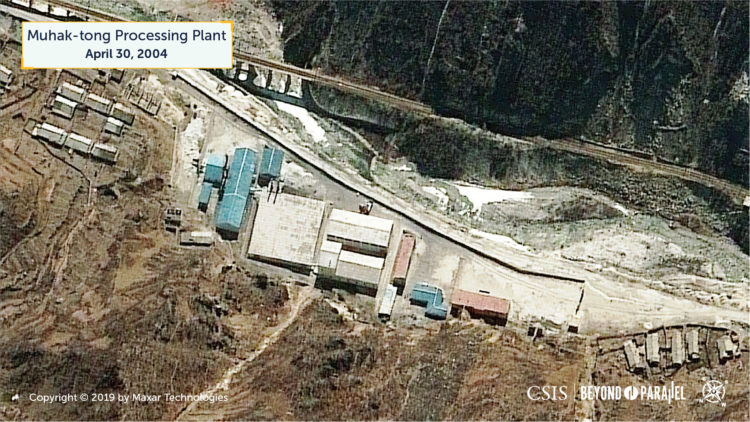

Located on the southern hill mass above Puktuilryong (Puktuil Pass) and the Puktae-chon Valley is the Puktu-dong Branch Mine – more commonly referred to as the Taehung Youth Hero Mine. Examination of satellite imagery indicates that it is a large-scale active surface mining operation that encompasses the villages of Puktu-dong, Sirubongdogi, Hakkyo-maul, a large surface mine, and several smaller surface mining activities (most of which appear abandoned). The village of Puktu-dong provides housing and support to the workers at the mine and appears to be the mine’s headquarters and logistics base. Sirubongdogi provides additional housing, and Hakkyo-maul appears to provide additional support. The main surface mine encompasses approximately 1.2 square kilometers, the vast majority of which is covered with tailings from the mine. At the center is a rock crusher with a conveyor belt system. Distributed around the mine and identifiable in satellite imagery are the mine headquarters and engineer offices, a gantry crane (for repairing heavy equipment), a vehicle maintenance and storage facility, an electricity substation, several smaller support buildings, and a number of housing areas.



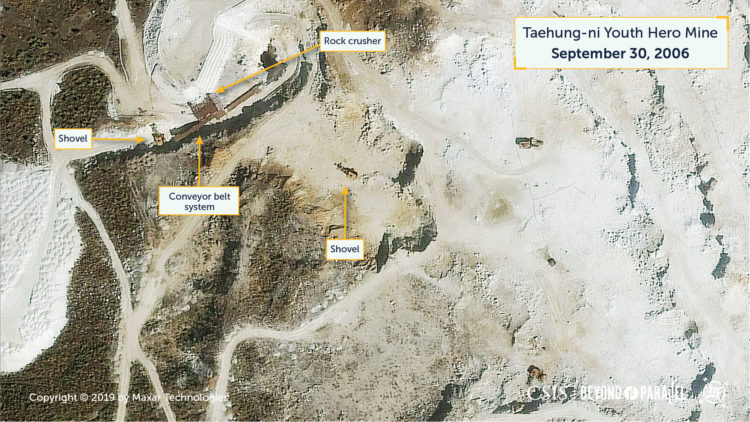

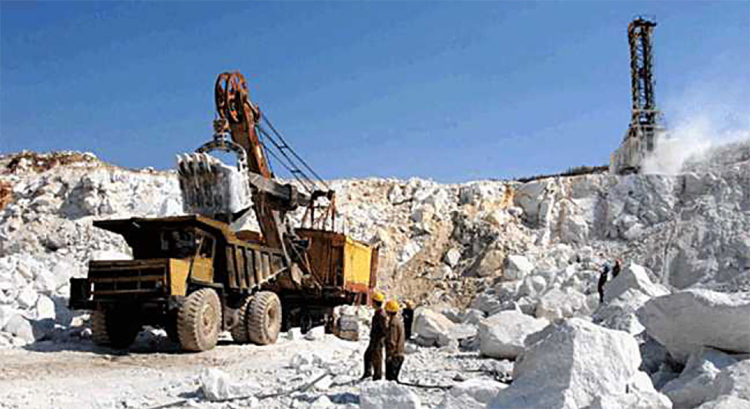

Open source reports state that the ore extracted here is sent by rail to the Taehung Magnesia Clinker Branch Factory and other processing facilities at Yangchon-dong. From there it is shipped by rail to Tanchon, where it is further processed at the Tanchon Magnesia Factory. It is then shipped by rail to the Songjin Refractory Plant in Kimchaek-si, Hambuk and elsewhere in the country, shipped by rail or sea to China, or shipped by sea in bulk carriers to foreign customers (see below).27
Available satellite imagery of the Taehung Youth Hero Mine and supporting activities at Sirubongdogi and Hakkyo-maul between from 2010-2018 is limited. While North Korean reports state that the mine was temporarily shut down as a result of the 2012 Typhoon Bolaven (Typhoon-15) it is unclear whether this was due to damage to the open pit mine itself or, more probably, to the railroad, roads, and processing facilities at Taehung-ni, Yangchon-dong, or Muhak-tong in the valley below. Regardless, similar reports indicate that the mine was fully operational by the end of 2013. Imagery from 2018 and 2019 shows that changes had occurred over the intervening years such as increasing footprints of tailings piles, shifting excavation activity, minor additions to small structures, razing of other structures, etc. This activity appears consistent with what would be expected from an open pit mine of this size in rural North Korea. At present, none of these changes can be specifically attributed to Typhoon Bolaven or to the imposition of international sanctions during 2016 and 2017.
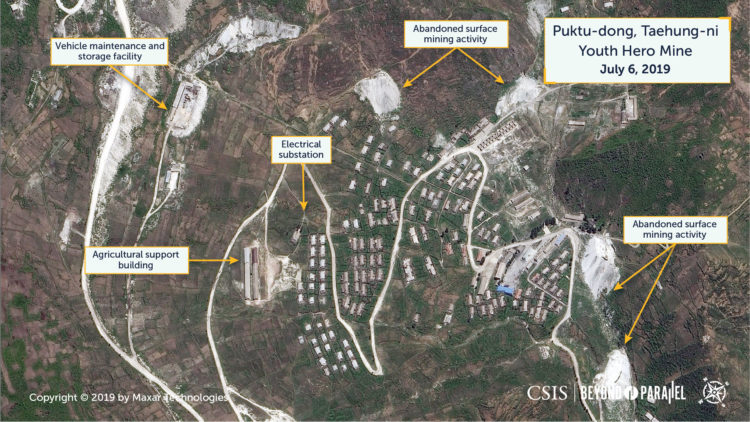
Overview of the Puktu-dong area and abandoned surface mining activity, Taehung Youth Hero Mine, July 6, 2019. (Copyright 2019 by Maxar Technologies) 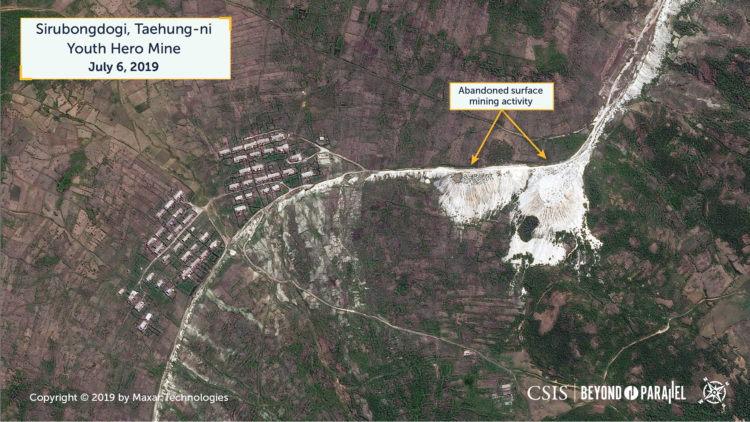
Overview of the Sirubongdogi area and abandoned surface mining activity, Taehung Youth Hero Mine, July 6, 2019. (Copyright 2019 by Maxar Technologies) 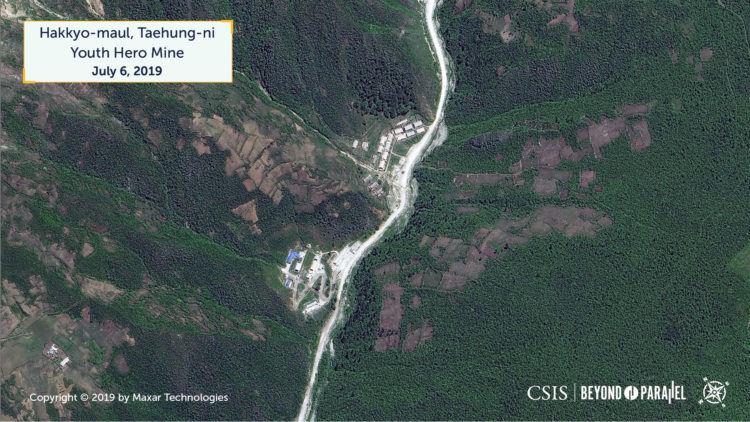
Overview of the Hakkyo-maul area, Taehung Youth Hero Mine, July 6, 2019. (Copyright 2019 by Maxar Technologies)
Economic Importance Acknowledged by Senior Officials
The Taehung Youth Hero Mine is frequently cited as playing a significant role in the nation’s economic development. Kim Jong-il and senior officials have visited the mine on a number of occasions and provided on-the-spot guidance or field guidance. During his 2009 visit to the mine, Kim Jong-il applauded the role of the mine in advancing North Korea’s industrial development and the “Juche-ification” of the people’s economy.28 During 2012, North Korean sources claimed that the Taehung Youth Hero Mine “boasts of billions of tons of [magnesite] deposits, which account for over 25 percent of the world’s magnesite deposits.”29 It reportedly was assigned an important role in North Korea’s implementation of the “five-year plan for national economic development” announced in 2016.30
While it is likely that Kim Il-sung also visited the mine during one of his inspection trips to Hamnam, no readily available information is available concerning any such visits. There are no readily available reports of Kim Jong-un visiting the mine since his assumption of power in 2011. While the attached timeline is not a complete listing of all senior leadership visits to the Taehung Youth Hero Mine, it provides an indication of its importance to the nation’s senior leadership.
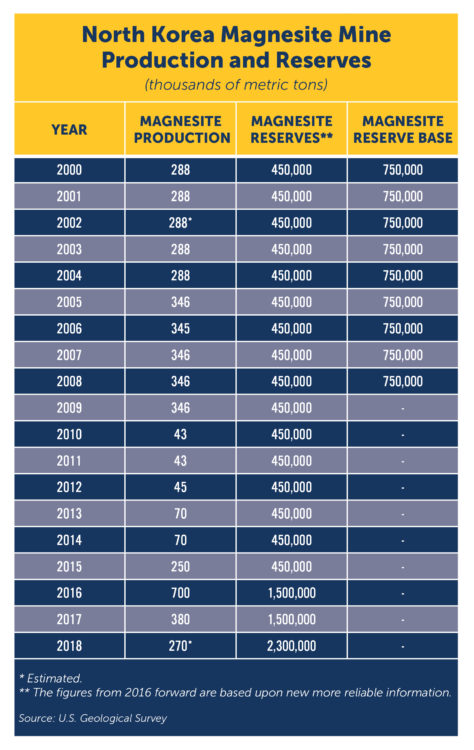
Engineering and University Research at the Taehung Youth Hero Mine
Researchers and engineers from the Taehung Youth Hero Mine are reported to be actively conducting research into a wide range of fields that have direct application to the mining sector, indicated by academic papers and reports published during the past 15 years.31 There is a report of a Taehung Industrial University that apparently undertakes mine-related research and education of workers and staff for the mines in the Taehung-ni area. Given its name and association with the Taehung Youth Hero Mine, it is likely that it is located in Taehung-ni. It is common practice in North Korea to have small industry-specific universities and schools co-located with large industrial complexes.
North Korean sources have frequently mentioned that research conducted at the Taehung Youth Hero Mine has led to the introduction of new mining methods to increase mineral output at the mine. For example, in 2017, Uriminzokkiri reported the introduction of a new “combined circular open-air – underground mining method” to create a “short-cut” to mine development. This new mining method was reportedly an “innovative plan to break the established theories of the world’s mining system” which stated that “the maximum marginal tilt-angle of the open-air mining site cannot exceed 45 degrees to bravely set the marginal tilt-angle to 57 degrees” in order to expand production capabilities while keeping production costs low. In a June 2019 article regarding the Taehung Youth Hero Mine, Ryomyong reported that rather than discarding powdered ore produced in the magnesite production process, the powder ore is now being converted into lumps of ore to be reused for the production of light-burned magnesia and magnesia clinkers. According to this report, 1,000 tons of reusable ore have already been produced.
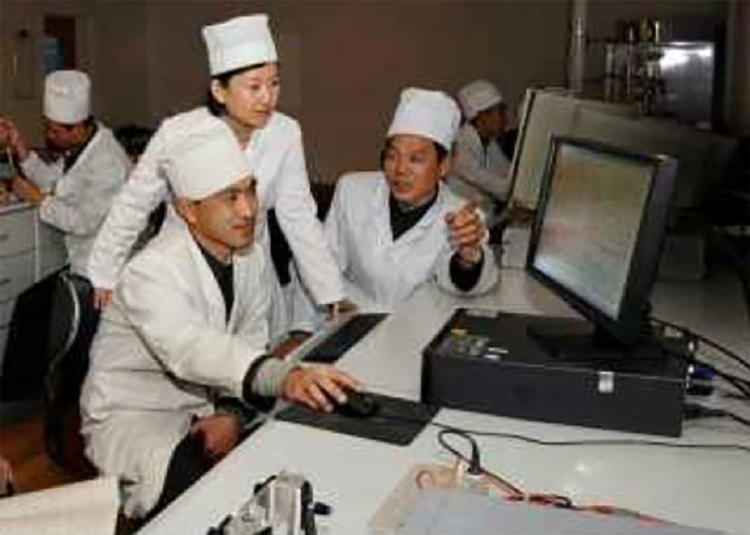
Several universities and industrial establishments have been mentioned in connection to supporting the operations at the Taehung Youth Hero Mine. For example, during 2011 researchers at the Pyongyang University of Light Industry contributed to the construction of anthracite briquette bonding agents, which are used for the production of magnesia clinker.32 During 2015 researchers at the Taehung Industrial University were reported to be undertaking a research project to determine a reasonable ventilation and wind pressure system in order to conserve electricity. The following year, scientists from the University of Natural Science, including the head of the chemistry department, Song Hak-chul, reportedly traveled to the Taehung Youth Hero Mine. There, they investigated ways of using phosphorus, which is commonly found in the area, as the raw material for creating a compound bonding agent.
Tanchon and Port of Tanchon
The port city of Tanchon is home to a number of industrial facilities that directly support the mining activities subordinate to the Tanchon District Mining Bureau.33 Most often cited are the Tanchon Magnesia Clinker Factory and Tanchon Mining Machine Factory.
The Tanchon Magnesia Factory is reportedly the largest magnesia manufacturing plant in North Korea, with a designed capacity of 2 million tons of magnesia per annum and is often cited as the nation’s powerful refractory producer.34
By rail it receives ore extracted not only from the Taehung Youth Hero Mine but also from the Ryongyang Mine and Komdok Mining Complex and clinker products from these mines to produce dozens of kinds of quality magnesia products, especially magnesia clinker, light burned magnesia and electrocast magnesia clinker. It also pushes the second- and third-stage processing. Reports also indicate that in association with the Taehung Youth Hero Mine and Ryongyang Mine that the Tanchon Magnesia Factory produces or supplies products to produce “chipboard and wainscot on an industrial basis. They continue to develop a variety of fine fixtures and building materials including door, newel, flowerpot, desk, shuttering and prop by raising the quality of slightly burned magnesia chipboard. Among the processed products is the roller for conveyor belt which is made of by-products from the magnesia clinker production process.”35
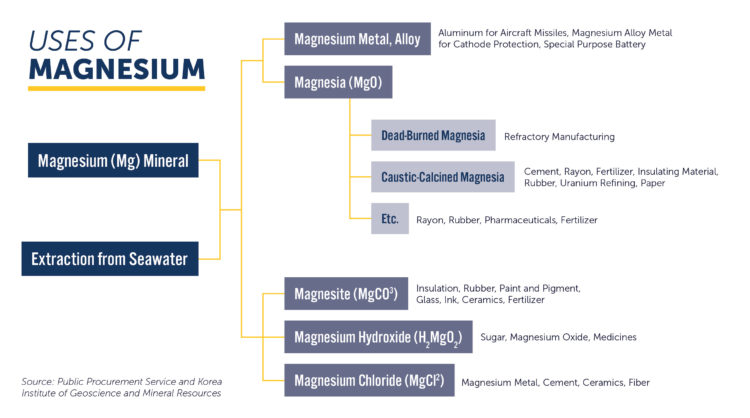
Other items produced with products from the Tanchon Magnesia Factory reportedly include magnesia cement, light burned magnesia fertilizer, pulp and paper, medicines and cosmetics.36 Magnesia cement is also used in the steel industry and can be used for optical equipment, rocket nozzles, and nuclear reactors.
The Tanchon Mining Machine Factory specializes in the production of large machinery and equipment used in the mines, factories, and enterprises in the Tanchon area. This factory appears to be subordinate to the Korea Zinc Industry Group located in Potonggang-guyok, Pyongyang. Among the products it reportedly produces are large ore-dressing machines and parts for pulverizing, sifting and flotation, electric cars, trams and their wheels, belt rolls, blowers, exhausters, reduction gears, compressors, magnesia clinker production facilities and other mining-related equipment.37


Aside from being used domestically, the magnesite ore and products produced by the Ryongyang Mine are shipped by sea through the ports of Tanchon and, to a lesser degree, Kimchaek in bulk carriers to foreign customers.38 A project to develop and expand the port was begun in 2010 and, in December 2011, it was reported that workers had completed two new breakwaters in 2 years rather than the projected 10 years estimated for completion.39 By 2012, the development project was essentially complete and enabled the port to “boost exports of magnesite, zinc and other mineral resources.” This itself was reportedly to enable the “port city of Tanchon [to] become the source of finance for the country’s broader policy line of pursuing both economic development and nuclear capacities.”40
References
- For an overview of North Koreas magnesite reserves see Mining North Korea: Magnesite Production at Ryongyang Mine. ↩
- “Taehung Youth Hero Mine,” Naenara, October 25, 2018, http://naenara.com.kp/ko/trade/?company+0+1315; Susan Wacaster, 2014 Minerals Yearbook: North Korea (Washington, D.C.: UUSGS, October 2017), https://s3-us-west-2.amazonaws.com/prd-wret/assets/palladium/production/mineral-pubs/country/2014/myb3-2014-kn.pdf; Kyung-soo Choi, “The Mining Industry of North Korea,” Korean Journal of Defense Analysis, Vol. 23, No. 2, June 2011, pp. 211-30, https://www.kci.go.kr/kciportal/ci/sereArticleSearch/ciSereArtiView.kci?sereArticleSearchBean.artiId=ART001738574; 2010 Minerals Yearbook: North Korea, (Washington, D.C.: U.S. Geological Survey, August 2012), p. 13.2; “Valuable Mountain of Korea,” KCNA, August 27, 2009; “Here come North Korean minerals,” Hankyoreh, May 9, 2007, http://www.hani.co.kr/arti/english_edition/e_international/208102.html; Magnesite Mine in Machon Mountains, KCNA, September 4, 1996; and “Production of Magnesia Clinker,” KCNA, April 20 1994. ↩
- That the mining and export of magnesite and the domestic production of products from it are important to the North Korean government and economy is indicated by the praise that the Taehung Youth Hero Mine and other magnesite mines and production facilities have routinely received from the North Korean leadership. For example, during October 2011 Kim Jong-il “once again expressed great satisfaction over the laudable feats performed by the workers of the above-said industrial establishments and the Taehung and Ryongyang mines in their endeavors to make a breakthrough toward the fulfillment of their national economy plans and consolidate the nations economic foundation.” ↩
- For example, Cho Kyewan. “Immense Underground Mineral ResourcesValue Comparable to that of Samsung and Hyundai,” Hankyoreh, May 02, 2018, http://www.hani.co.kr/arti/PRINT/842906.html; Mollman, Steve. “North Korea is sitting on trillions of dollars of untapped wealth, and its neighbors want in,” QZ.com, June 15, 2017, accessed June 1, 2019, https://qz.com/1004330/north-korea-is-sitting-on-trillions-of-dollars-on-untapped-wealth-and-its-neighbors-want-a-piece-of-it/; “Underground resources in North Korea, Magnesite, which accounts for half of the world’s reserves,” NK Today, March 25, 2014, http://nktoday.kr/?p=2172;” Inter-Korean coal mine projects suspended during Lee administration,” Hankyoreh, April 25, 2011, http://english.hani.co.kr/arti/english_edition/e_northkorea/474670.html; and “Here come North Korean minerals,” Hankyoreh, May 9, 2007, http://www.hani.co.kr/arti/english_edition/e_international/208102.html. ↩
- “Locations of Rare Earth Minerals Reserves in North Korea,” JoongAng Ilbo, May 23, 2019. https://news.joins.com/article/23476628; Quan Zhenan and Li Gengqian, “North Korean Mineral Resources: Rich Reserves, Weak Development, and Great Potential for Cooperation”, Shijie Zhishi, September 2018, p. 25-27; and “Special Series on North Korea’s Underground Reserves: Half of the World’s Magnesite Reserves,” NK Today, March 35, 2014, http://nktoday.kr/?p=2172. ↩
- “Locations of Rare Earth Minerals Reserves in North Korea,” JoongAng Ilbo, May 23, 2019. https://news.joins.com/article/23476628; Quan Zhenan and Li Gengqian, “North Korean Mineral Resources: Rich Reserves, Weak Development, and Great Potential for Cooperation,” Shijie Zhishi, September 2018, p. 25-27; and “Special Series on North Korea’s Underground Reserves: Half of the World’s Magnesite Reserves,” NK Today, March 35, 2014, http://nktoday.kr/?p=2172. Additionally, there is the Chongjin Refractory Factory in Chongjin-si, Hambuk province. ↩
- During the 1990s, the mine was often referred to as the Taehng Youth General Mining Enterprise. For example, “Magnesite Mine in Machon Mountains,” KCNA, September 4, 1996; and “Kim Chong-il Thanks Officers for Army-People Unity,” KCNA, July 25, 1996. ↩
- “Area has Bright Prospect for Magnesite Products,” Pyongyang Times, April 7, 2018, https://kcnawatch.org/newstream/1532001660-334105039/area-has-bright-prospect-for-magnesite-products/; and “Valuable Mountain of Korea,” KCNA, August 27, 2009. ↩
- This bureau is sometimes identified as the Tanchon Area Associated Mining Bureau or General Bureau of the Tanchon Area Mining Industry. ↩
- “Korea General Magnesia Clinker Industry Group,” Naenara, April 12, 2013; Kyung-soo Choi, “The Mining Industry of North Korea,” Korean Journal of Defense Analysis, Vol. 23, No. 2, June 2011, pp. 211-30. ↩
- Taehung Youth Hero Mine, Foreign Trade, 2018, No. 107-03, pp. 2-3 and Cho Kyewan.
“Immense Underground Mineral Resources… Value Comparable to that of Samsung and Hyundai,” Hankyoreh, May 2, 2018. Information in this report appears to be the basis for a later Chinese report. See: Quan Zhenan and Li Gengqian. “North Korean Mineral Resources: Rich Reserves, Weak Development, and Great Potential for Cooperation” Shijie Zhishi, September 2018, pp. 25-27. ↩ - Taehung Youth Hero Mine, Foreign Trade, 2018, No. 107-03, pp. 2-3 and Cho Kyewan. “Immense Underground Mineral Resources… Value Comparable to that of Samsung and Hyundai,” Hankyoreh, May 2, 2018. Information in this report appears to be the basis for a later Chinese report. See: Quan Zhenan and Li Gengqian. “North Korean Mineral Resources: Rich Reserves, Weak Development, and Great Potential for Cooperation” Shijie Zhishi, September 2018, pp. 25-27. ↩
- “Taehung Youth Hero Mine,” Naenara, October 25, 2018; Cho Kyewan.
“Immense Underground Mineral Resources… Value Comparable to that of Samsung and Hyundai,” Hankyoreh, May 2, 2018; “Taehung Youth Hero Mine, the world’s leading mine,” KCNA, June 1, 2012; and General Secretary Kim Jong-il provides on-site inspection of Taehung Youth Hero Mine and Ryongyang Mine, KCNA, October 15, 2011. ↩ - Other reported products produced by the Taehung Magnesia Clinker Branch Factory include light burned magnesia with locally available fuel, instead of cokes . . . (and) alcohol by use of sawdust, making quality bond from its by-product for using it for the molding of anthracitic oval briquette, produces tiles, roofing tiles and powdered magnesium hydroxide.” Cho Kyewan, “Immense Underground Mineral Resources Value Comparable to that of Samsung and Hyundai,” Hankyoreh, May 2, 2018, http://www.hani.co.kr/arti/PRINT/842906.html; “Taehung Youth Hero Mine, the worlds leading mine,” KCNA, June 01, 2012, https://bit.ly/343XYEE; and “General Secretary Kim Jong-il provides on-site inspection of Taehung Youth Hero Mine and Ryongyang Mine,” KCNA, October 15, 2011. See also Zhenan and Gengqian, “North Korean Mineral Resources,” p. 25-27. ↩
- Kyung-soo Choi, “The Mining Industry of North Korea,” Korean Journal of Defense Analysis, Vol. 23, No. 2, June 2011, pp. 211-30. The Songjin Refractory Factory is sometimes identified as the Songjin Fireproof Material Factory. ↩
- Kyung-soo Choi, “The Mining Industry of North Korea,” Korean Journal of Defense Analysis, Vol. 23, No. 2, June 2011, pp. 211-30 and “Here come North Korean minerals,” Hankyoreh, May 9, 2007. ↩
- Kyung-soo Choi, “The Mining Industry of North Korea,” Korean Journal of Defense Analysis, Vol. 23, No. 2, June 2011, pp. 211-30 and ”
Here come North Korean minerals,” Hankyoreh, May 9, 2007. ↩ - “Let’s secure the continued development of the unit with our own strength like the workers of the Taehung Youth Hero Mine,” Uriminzokkiri, November 20, 2018. ↩
- “Valuable Mountain of Korea,” KCNA, August 27, 2009. ↩
- Despite this popular name for this rail line, it should be more correctly the Tanchon- Muhak-tong rail line, as the Muhak-tong station and rail yard are the end of the line- significantly past the Kumgol Station. ↩
- “Taehung Youth Hero Mine,” Naenara, October 25, 2018, http://naenara.com.kp/ko/trade/?company+0+1315; “Taehung Youth Hero Mine,” Foreign Trade, p. 2-3; “Big Increase in the Production of Magnesia Clinker and Light-Burned Magnesia,” DPRK Today, October 27, 2017, http://dprktoday.com/index.php?type=2&no=26155; and “Magnesite Mine in Machon Mountains,” KCNA, September 4, 1996. ↩
- Sometimes described as the “Puktu-dong open pit mine” or “Pukdu Large Open-Air Mining Site.” The village of Puktu-dong (북투동) is located at 41.074627 128.903825. ↩
- Sometimes described as the “Muhak Underground Mining Site” or “Muhak-tong underground stopes.” The village of Muhak-tong (무학동) is located at 41.095794 128.882504. ↩
- Sometimes described as the “Electric Fusion Magnesia Clinker Base.” The village of Yangchon-dong () is located at 41.065927 128.853761. ↩
- Sometimes described as the “Light-burned Magnesia Production Base.” ↩
- “Big Increase in the Production of Magnesia Clinker and Light-Burned Magnesia,” DPRK Today, October 27, 2017, http://dprktoday.com/index.php?type=2&no=26155; and Kyung-soo Choi, “The Mining Industry of North Korea,” Korean Journal of Defense Analysis, Vol. 23, No. 2, June 2011, pp. 211-30, https://www.kci.go.kr/kciportal/ci/sereArticleSearch/ciSereArtiView.kci?sereArticleSearchBean.artiId=ART001738574. ↩
- Quan Zhenan and Li Gengqian. North Korean Mineral Resources: Rich Reserves, Weak Development, and Great Potential for Cooperation, Shijie Zhishi, September 2018, pp. 25-27. ↩
- Anecdotes of Kim Jong Ils Life, Vol. 3 (Foreign Languages Publishing House: Pyngyang, 2016), p. 109-110; “Kim Jong Il’s Field Guidance This Year,” KCNA, December 26, 2009; “Kim Jong Il Gives Field Guidance to Mines in Komdok Area,” KCNA, May 21, 2009; “Kim Jong Il Gives Guidance to Komdok Mines,” KCBS, May 20, 2009; and “N. Korean Leader Visits Mines in Remote Province,” Yonhap, May 21, 2009. ↩
- “Taehung Youth Hero Mine,” KCNA, June 1, 2012. ↩
- Fifield, Anna. “North Korea announces five-year economic plan, its first since the 1980s,” Washington Post, May 8, 2016, https://www.washingtonpost.com/world/north-korea-announces-economic-plan-after-unprecedentedly-grim-struggle/2016/05/08/c84088e2-1214-11e6-a9b5-bf703a5a7191_story.html and “Premier Pak Pong-ju provides on-site inspection of mines and industrial establishments in Komdok District,” Rodong Sinmun, November 30, 2016, https://bit.ly/32ItQOJ. ↩
- As an example, see: Inventions, Palmyo’ng Kongbo, October 5, 2005, p. 39. ↩
- “Briquette Bonding Agent Production Process Established and Production Expanded at the Taehung Youth Hero Mine,” KCNA, March 16, 2016; and “The University that helps factories with science and technology,” KCNA, May 9, 2011, https://bit.ly/34gTkTA. ↩
- “Korea General Magnesia Clinker Industry Group,” Naenara, April 12, 2013. ↩
- “Area has Bright Prospect for Magnesite Products,” Pyongyang Times, April 17, 2018, https://kcnawatch.org/newstream/1532001660-334105039/area-has-bright-prospect-for-magnesite-products; and Kyung-soo Choi, “The Mining Industry of North Korea,” Korean Journal of Defense Analysis, Vol. 23, No. 2, June 2011, pp. 211-30, https://www.kci.go.kr/kciportal/ci/sereArticleSearch/ciSereArtiView.kci?sereArticleSearchBean.artiId=ART001738574. During the 1990s this facility was often referred to as the “Tanchon Magnesia Factory.” See “Magnesite Mine in Machon Mountains,” KCNA, September 4, 1996. ↩
- “Area has Bright Prospect for Magnesite Products,” Pyongyang Times, April 17, 2018, https://kcnawatch.org/newstream/1532001660-334105039/area-has-bright-prospect-for-magnesite-products; and Kyung-soo Choi, “The Mining Industry of North Korea,” Korean Journal of Defense Analysis, Vol. 23, No. 2, June 2011, pp. 211-30, https://www.kci.go.kr/kciportal/ci/sereArticleSearch/ciSereArtiView.kci?sereArticleSearchBean.artiId=ART001738574. ↩
- “Area has Bright Prospect for Magnesite Products,” Pyongyang Times, April 17, 2018, https://kcnawatch.org/newstream/1532001660-334105039/area-has-bright-prospect-for-magnesite-products; and Kyung-soo Choi, “The Mining Industry of North Korea,” Korean Journal of Defense Analysis, Vol. 23, No. 2, June 2011, pp. 211-30, https://www.kci.go.kr/kciportal/ci/sereArticleSearch/ciSereArtiView.kci?sereArticleSearchBean.artiId=ART001738574. ↩
- “Tanchon Mining Machine Factory,” Foreign Trade, p. 3-4. ↩
- “Tanchon Mining Machine Factory,” Foreign Trade, p. 3-4.; Zhenan and Gengqian, “North Korean Mineral Resources,” p. 25-27; “Kim Jong Il Gives Field Guidance to Major Industrial Establishments in Hamhung City,” KCNA, October 16. 2011, http://kcna.co.jp/item/2011/201110/news16/20111016-26ee.html; and “Kim Jong Il Gives Field Guidance to Taehung Youth Hero Mine and Ryongyang Mine,” KCNA, October 15, 2011. ↩
- “Many Economic Achievements Made in DPRK This Year,” KCNA, December 15, 2011. ↩
- Many Economic Achievements Made in DPRK This Year, KCNA, December 15, 2011; Taehung Youth Hero Mine, Foreign Trade, 2018, No. 107-03, pp. 2-3; Quan Zhenan and Li Gengqian. North Korean Mineral Resources: Rich Reserves, Weak Development, and Great Potential for Cooperation, Shijie Zhishi, September 2018, pp. 25-27; N. Korea aims to develop resource-rich Tanchon, Yonhap, April 25, 2013, https://en.yna.co.kr/view/AEN20130425006800315; Tanchon Port reconstruction completed, North Korea Economic Watch, April 25, 2013, http://www.nkeconwatch.com/2013/04/25/tanchon-port-reconstruction-to-be-completed-by-2012/; and Kyung-soo Choi, The Mining Industry of North Korea, Korean Journal of Defense Analysis, Vol. 23, No. 2, June 2011, pp. 211-30, https://www.kci.go.kr/kciportal/ci/sereArticleSearch/ciSereArtiView.kci?sereArticleSearchBean.artiId=ART001738574. ↩
